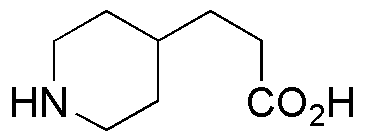3-Piperidin-4-yl-propionic acid hydrochloride is widely utilized in research focused on:
- Pharmaceutical Development: This compound serves as a key intermediate in the synthesis of various pharmaceuticals, particularly in the development of drugs targeting neurological disorders.
- Neurotransmitter Research: It is used in studies to understand the role of neurotransmitters, aiding in the development of treatments for conditions like depression and anxiety.
- Analytical Chemistry: The compound is employed as a standard in analytical methods to quantify related substances, ensuring accuracy in drug formulation and quality control.
- Biochemical Studies: Researchers utilize it to investigate metabolic pathways and enzyme interactions, providing insights into cellular processes and potential therapeutic targets.
- Material Science: It finds applications in creating specialized polymers and materials, enhancing properties such as flexibility and strength for industrial uses.
General Information
Properties
Safety and Regulations
Applications
3-Piperidin-4-yl-propionic acid hydrochloride is widely utilized in research focused on:
- Pharmaceutical Development: This compound serves as a key intermediate in the synthesis of various pharmaceuticals, particularly in the development of drugs targeting neurological disorders.
- Neurotransmitter Research: It is used in studies to understand the role of neurotransmitters, aiding in the development of treatments for conditions like depression and anxiety.
- Analytical Chemistry: The compound is employed as a standard in analytical methods to quantify related substances, ensuring accuracy in drug formulation and quality control.
- Biochemical Studies: Researchers utilize it to investigate metabolic pathways and enzyme interactions, providing insights into cellular processes and potential therapeutic targets.
- Material Science: It finds applications in creating specialized polymers and materials, enhancing properties such as flexibility and strength for industrial uses.
Documents
Safety Data Sheets (SDS)
The SDS provides comprehensive safety information on handling, storage, and disposal of the product.
Product Specification (PS)
The PS provides a comprehensive breakdown of the product’s properties, including chemical composition, physical state, purity, and storage requirements. It also details acceptable quality ranges and the product's intended applications.
Certificates of Analysis (COA)
Search for Certificates of Analysis (COA) by entering the products Lot Number. Lot and Batch Numbers can be found on a product’s label following the words ‘Lot’ or ‘Batch’.
Número de catálogo
Número de lote/lote
Certificates Of Origin (COO)
This COO confirms the country where the product was manufactured, and also details the materials and components used in it and whether it is derived from natural, synthetic, or other specific sources. This certificate may be required for customs, trade, and regulatory compliance.
Número de catálogo
Número de lote/lote
Safety Data Sheets (SDS)
The SDS provides comprehensive safety information on handling, storage, and disposal of the product.
DownloadProduct Specification (PS)
The PS provides a comprehensive breakdown of the product’s properties, including chemical composition, physical state, purity, and storage requirements. It also details acceptable quality ranges and the product's intended applications.
DownloadCertificates of Analysis (COA)
Search for Certificates of Analysis (COA) by entering the products Lot Number. Lot and Batch Numbers can be found on a product’s label following the words ‘Lot’ or ‘Batch’.
Número de catálogo
Número de lote/lote
Certificates Of Origin (COO)
This COO confirms the country where the product was manufactured, and also details the materials and components used in it and whether it is derived from natural, synthetic, or other specific sources. This certificate may be required for customs, trade, and regulatory compliance.

